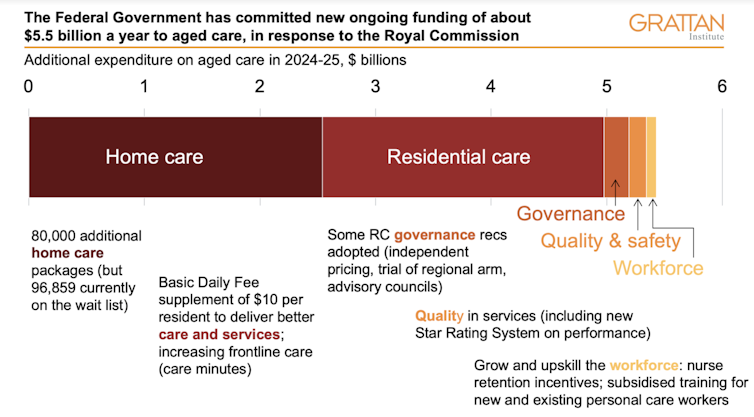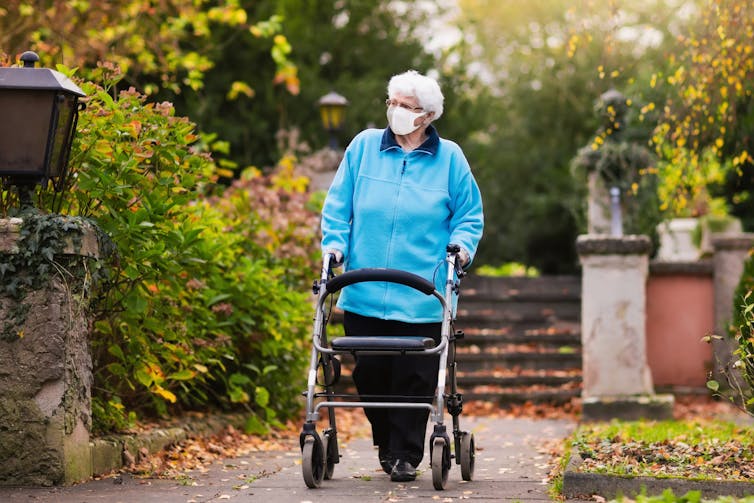Source: The Conversation (Au and NZ) – By Stephen Duckett, Director, Health Program, Grattan Institute
The big investment in aged care announced in last night’s federal budget – an extra A$17.7 billion over five years – is a welcome response to the Royal Commission into Aged Care Quality and Safety. But even an investment of this scale does not meet the level of ambition set by the royal commission.
The government has committed A$6.5 billion for more home-care packages (about A$2.5 billion more for home care per year when fully implemented), and A$7.1 billion for residential-care staffing and services (about $2.4 billion more for residential care per year when fully implemented).
But the government has failed to outline a clear vision of what older Australians should expect of their aged-care system.
Read more: Fewer hard hats, more soft hearts: budget pivots to women and care
Immediate fixes with no guarantees
The budget includes funding for 80,000 extra home-care packages over two years. The current home-care packages program has numerous problems, including nearly a 100,000-strong waiting list.But the government has not explicitly promised to clear the waiting list and bring waiting times down to 30 days, as the royal commission called for.
The budget has some good news for people in residential aged care. The Basic Daily Fee (for services including food) will be increased by A$10 per resident per day, as called for by the royal commission.
And there’s more funding for better staffing, with mandates for an average of at least 200 minutes of care for every resident every day (40 minutes of which must be by a nurse) by 2023.
This is a good start, given nearly 60% of residents presently get less than this. But residents will have to wait two years – not one, as recommended by the royal commission – before they get more care hours.
Read more: If we have the guts to give older people a fair go, this is how we fix aged care in Australia
The budget also provides additional funding to improve the aged-care workforce. The government will subsidise the training of new and existing aged-care workers, including 33,800 places to attain Certificate III.
But the government has not gone far enough in supporting the workforce. It stopped short of guaranteeing that every staff member providing care for older Australians will be trained to a minimum Certificate III level, and that all residential aged-care facilities will have a registered nurse on site 24 hours a day.
The budget commitments appear to be a once-off, with workforce funding plummeting to only A$86.5 million in 2024-25, compared to A$293.3 million in 2022-23. And there is no commitment to lift carers’ wages.

Small steps towards a better system
The royal commission made it clear the aged-care system needed to be reformed from top to bottom. The government’s announcements foreshadow a shake-up of the system over five years. But the extent of reform is yet to be determined.
The budget papers show funding will be up by about A$5.5 billion per year once most reforms are in (see the chart below). That’s not enough to create a needs-driven, rights-based system, called for by the royal commission and the Grattan Institute.

The government has committed to a new Aged Care Act, to be legislated by mid-2023, though the details are yet to be filled in. This Act must put the rights of older Australians at its heart.
The government has also committed to designing a new home care program and will provide a single assessment process for both home care and residential care.

A local network of health department staff will be embedded in the regions, and there will be a network of 500 “care finders” to help older Australians get the support they need.
But the biggest risk to achieving real structural change is governance and transparency. Here, the government has fallen short.
Read more: 4 key takeaways from the aged care royal commission’s final report
The government does not support the establishment of an independent aged care commission. Most disappointingly, it is pumping A$260 million into the Aged Care Quality and Safety Commission, which the royal commission found had demonstrably failed.
While some transparency will be provided through public reporting of staffing hours and star ratings to compare provider performance, clear transparency measures will be needed to ensure the additional billions don’t end up boosting providers’ profits.
The good news from budget 2021 is that the journey has begun. The government has made a substantial down payment to allow development of a new aged-care system. We must hope that more will follow, so the neglect ends and every older Australian can get the care and support they need.
– ref. Budget package doesn’t guarantee aged-care residents will get better care – https://theconversation.com/budget-package-doesnt-guarantee-aged-care-residents-will-get-better-care-160611







